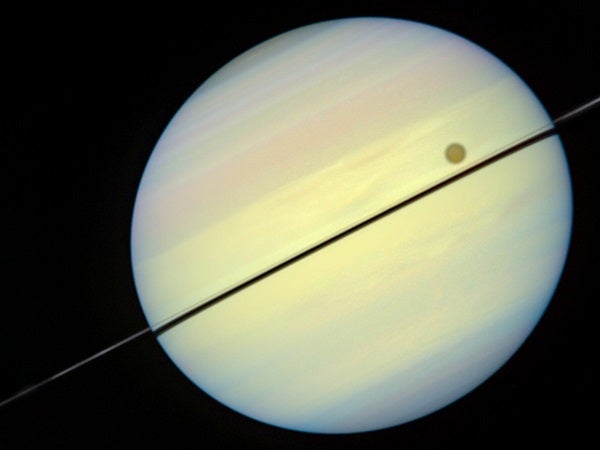Combustion, or burning, is a process where a fuel such as methane undergoes a sequence of exothermic chemical reactions that release energy when interacting with an oxidizing compound (usually molecular oxygen). In Earth’s atmosphere, the overall methane reaction is: methane + 2 molecular hydrogen molecules → carbon dioxide + 2 water molecules + energy.
The main constituents of Titan’s atmosphere near the satellite’s surface are molecular nitrogen, methane, and molecular hydrogen in approximate ratios of 0.95 to 0.049 to 0.001, respectively. The atmosphere contains no free molecular oxygen. In fact, the most abundant molecule with an oxygen atom is carbon monoxide, at 50 parts per million. Carbon monoxide is an end product of incomplete combustion and has one of the strongest chemical bonds for diatomic molecules. Therefore, it is impossible for methane — with a chemical bond strength less than half that of carbon monoxide’s — to interact with carbon monoxide in an exothermic, heat-releasing reaction.
The main constituents of Titan’s atmosphere near the satellite’s surface are molecular nitrogen, methane, and molecular hydrogen in approximate ratios of 0.95 to 0.049 to 0.001, respectively. The atmosphere contains no free molecular oxygen. In fact, the most abundant molecule with an oxygen atom is carbon monoxide, at 50 parts per million. Carbon monoxide is an end product of incomplete combustion and has one of the strongest chemical bonds for diatomic molecules. Therefore, it is impossible for methane — with a chemical bond strength less than half that of carbon monoxide’s — to interact with carbon monoxide in an exothermic, heat-releasing reaction.
Thus, methane would not burn in Titan’s atmosphere in the normal sense of combustion. But ultraviolet photons and reactive molecules, such as molecular carbon and methane, can chemically break the carbon-hydrogen bonds in methane to produce more complex hydrocarbons — such as acetylene, ethylene, ethane, propane, benzene, etc. This chemical conversion of methane to more complex hydrocarbons is an irreversible process because the hydrogen atoms and molecules released ultimately escape out the top of Titan’s atmosphere. — Darrell Strobel, Johns Hopkins University, Baltimore, Maryland










